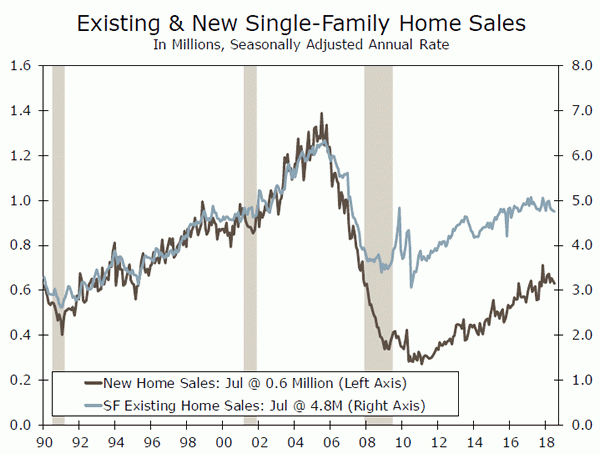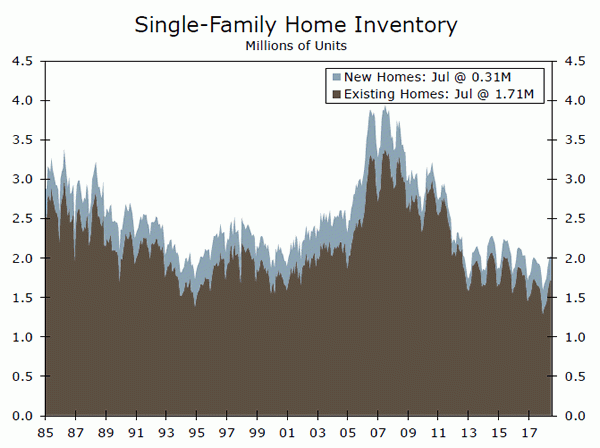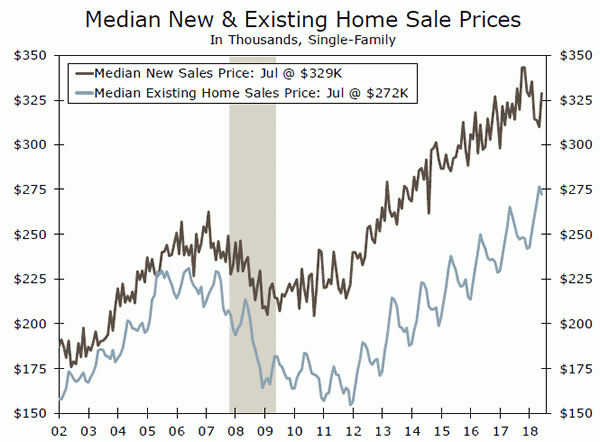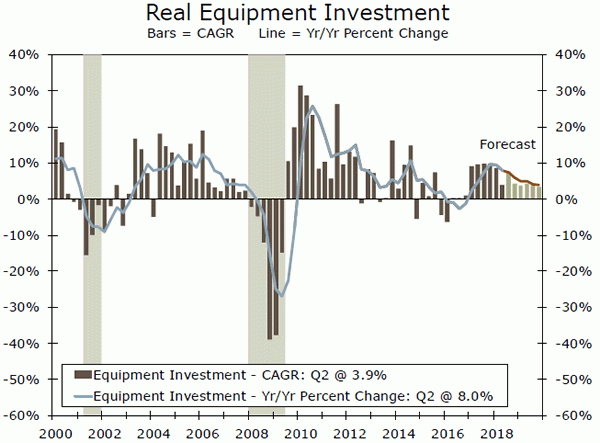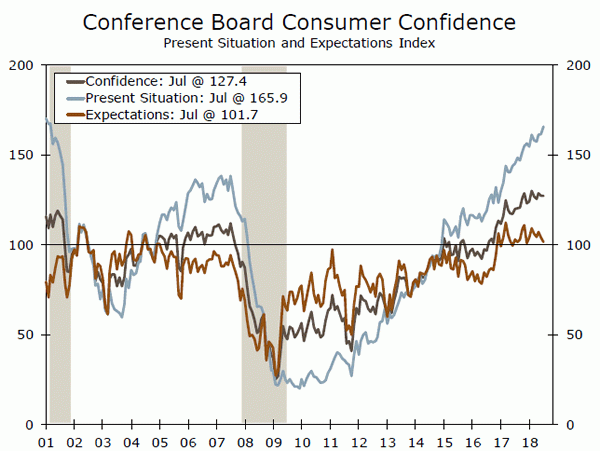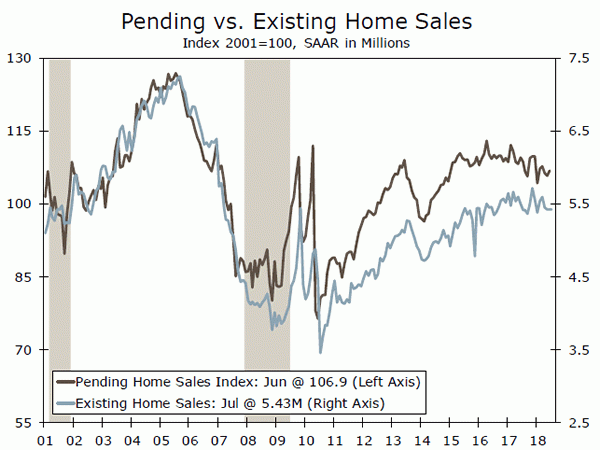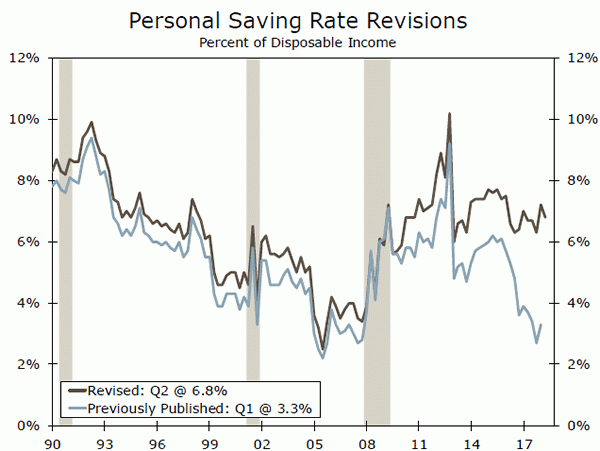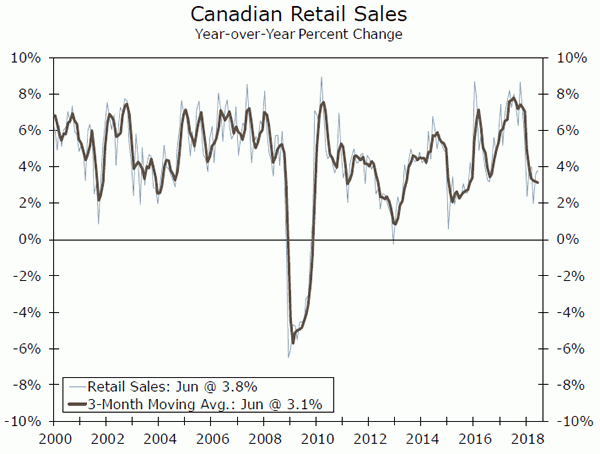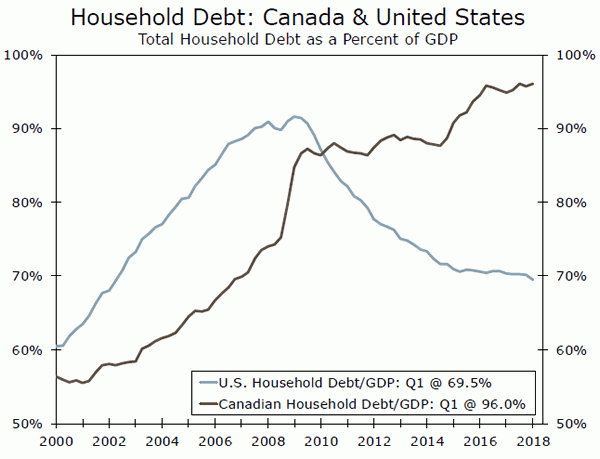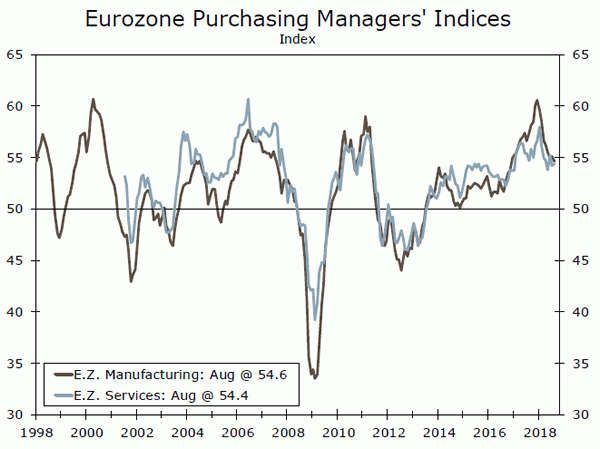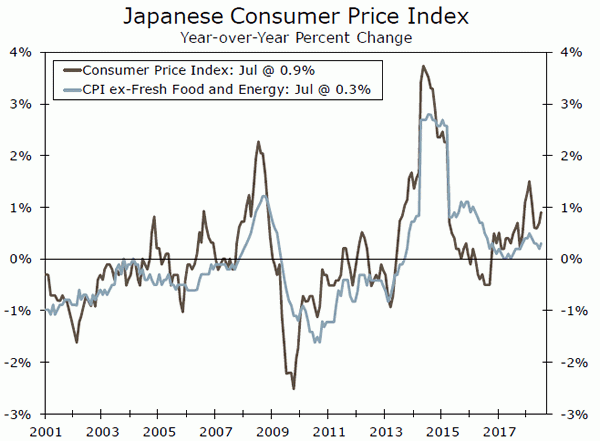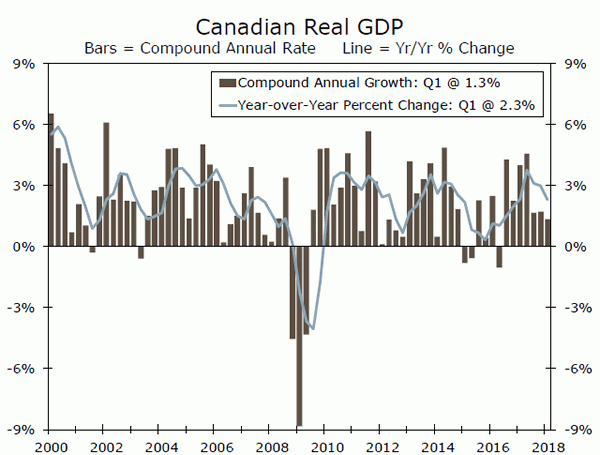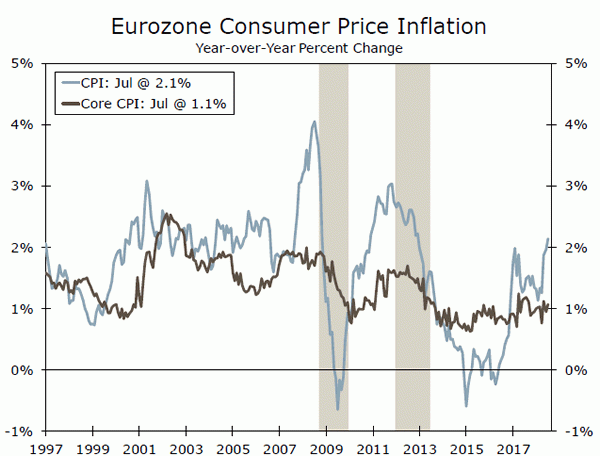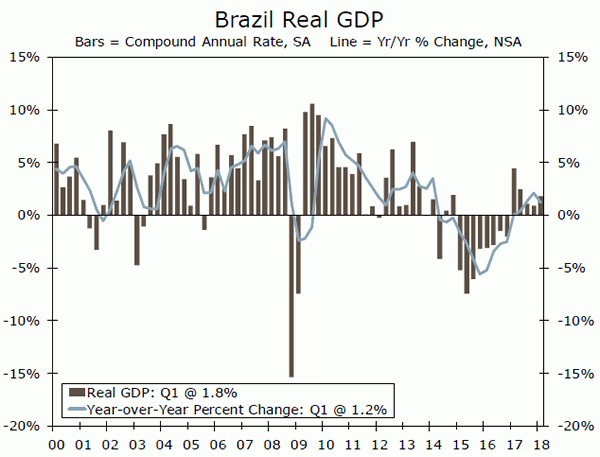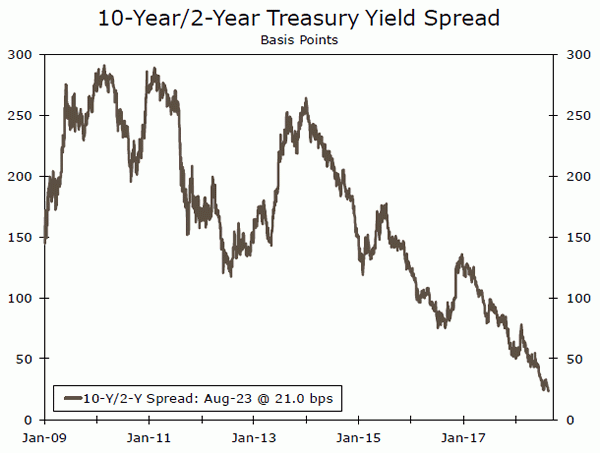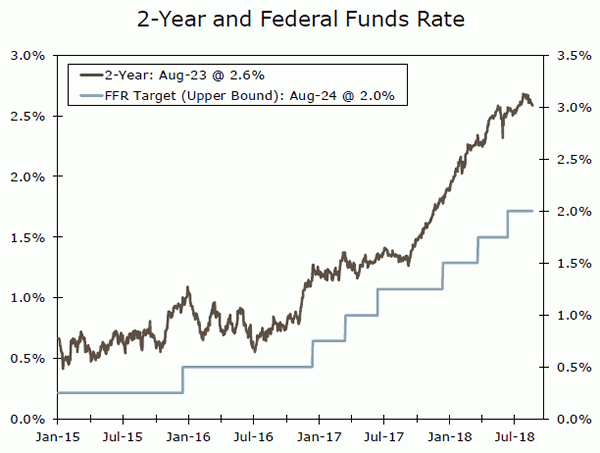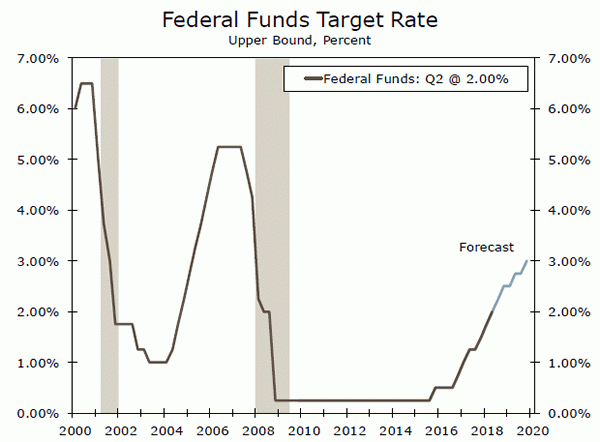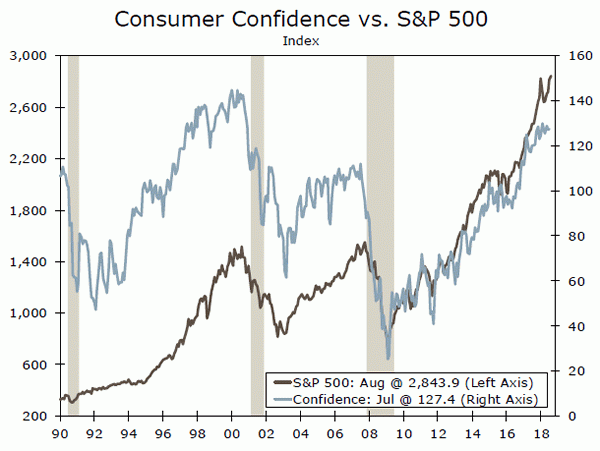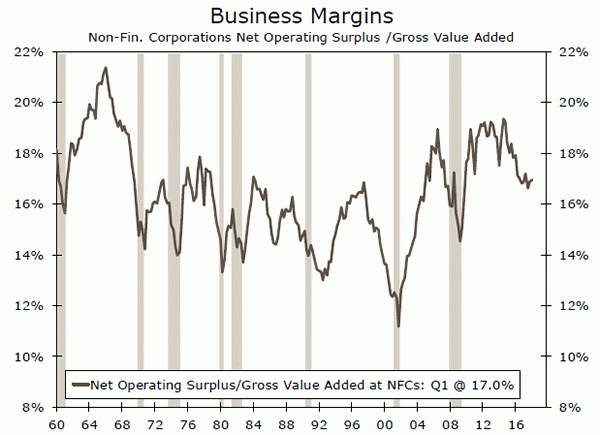U.S. Review
The Housing Disconnect
- Existing homes sales declined 0.7 percent to a 5.34-million unit pace in July. Total resales are now trending 1.5 percent below year-ago levels. Sales of new homes also fell, down 1.7 percent in July following a 2.4 percent drop in June.
- Durable goods orders slipped 1.7 percent in July. Much of the decline occurred from an expected drop in nondefense aircraft orders. Ex-transportation, orders rose 0.2 percent.
- The latest FOMC meeting minutes revealed that participants’ views of the economic outlook had strengthened, making a September rate hike increasingly likely.
The Housing Disconnect
The week was replete with data that underscored the divide between a sluggish housing sector and an overall improving economy, as both new and existing home sales again came in below expectations in July. Meanwhile, minutes for the most recent FOMC meeting revealed that the committee appears on track for a September rate hike. Despite volatility in the transportation sector, a pickup in core capital goods orders bodes well for third quarter business equipment investment.
Existing homes sales declined 0.7 percent to a 5.34-million unit pace in July. Single-family sales fared slightly better and only experienced a 0.2 percent drop, while condos and co-ops fell 4.8 percent. Total resales have now declined on a monthly basis in each of the past four months and are trending 1.5 percent below year-ago levels. The parade of disappointing housing data continued with new home sales, which also came in below consensus and fell 1.7 percent in July. The monthly decline followed a 2.4 percent drop in June. Sales of new homes have now fallen in three of the past four months.
Several factors appear to be limiting home sales, but we doubt waning demand is one of them. Existing homes only lasted an average of 27 days on the market, slightly less than the 30-day average registered in July 2017. Fifty-five percent of the existing homes sold were also on the market for less than a month. Tight inventories are more of a concern. On a year-over-year basis, total inventories of existing homes remained essentially flat; however, this followed 37 consecutive months of declines. Home prices also remain high. The National Association of Realtors reported that the median home price for an existing single family home eased somewhat to $272,300, but this followed prices hitting a record high of $276,500 in June. Both the average and median home price for new homes also rose during the month.
The weather may have also dampened sales in July. The Northeast experienced an unusual amount of rain and saw sales of both new and existing homes drop sharply during the month. Parts of the South may have also been affected. However, home sales clearly remain on the slow track and the divide between the strengthening economy and sluggish housing market is a theme that should persist.
Topline durable goods orders slipped 1.7 percent in July. However, much of the monthly drop was in the transportation sector, as both civilian and military aircraft orders fell more than 34 percent. Excluding the volatile transportation component, there was fairly broad-based strength, as orders increased 0.2 percent, and nondefense capital goods orders excluding aircraft rose 1.4 percent. With orders in other categories still positive and unfilled orders of nondefense aircraft elevated, we maintain our call for real equipment spending to rise in Q3.
To cap the week, Fed Chair Powell gave a speech in Jackson Hole on Friday. He emphasized his view that the economy has “strengthened substantially” and there is “little risk of overheating.” This makes a September rate hike all the more likely, as the minutes of the latest FOMC meeting released earlier this week revealed that participants’ views of the economic outlook had also strengthened despite the noted potential downside risks of trade and the housing sector. This also firms up our stance that the Fed should hike rates two more times this year in September and December, with two additional quarter-point hikes in 2019.
U.S. Outlook
Consumer Confidence • Tuesday
Consumer confidence rose 0.3 points in July, while June’s drop was revised lower than first reported. Consumers generally continue to remain upbeat about current economic conditions. The present situation index rose 4.2 points in July, registering a new cycle high of 165.9. However, consumers are growing slightly more concerned about future economic conditions. All of the drag came from the future expectations component in July, which, falling 2.3 points, marks the second consecutive decline and fourth drop in the past five months. The growing divide between consumers’ assessment of current economic conditions and their expectations of the future partly reflects uncertainty surrounding the ongoing trade negotiations and disputes. Despite these uncertainties, we expect consumer confidence to remain elevated in August, although we anticipate the divide between present and future conditions to continue to widen as this economic cycle ages.
Previous: 127.4 Wells Fargo: 126.4 Consensus: 126.5
Pending Home Sales • Wednesday
After declining for two consecutive months, pending home sales rose 0.9 percent in June. Since pending home sales measure purchase contracts for existing homes, pending sales tend to lead existing sales by one or two months. However, data released this week showed existing home sales fell 0.7 percent in July, largely due to tight inventories and rising home prices.
The inventory and affordability story is also prevalent in the pending home sales numbers. Low inventories are driving prices higher, which appears to have softened buyer interest, but may be a sign of more sellers eventually coming to market. Higher interest rates also appear to have had an impact on the housing market. Mortgage rates have picked up over the past year, which are contributing to the cost of purchasing a home. We expect home sales to pick up in the second half of the year, but to finish 2018 at levels slightly lower than last year.
Previous: 0.9% Consensus: 0.5% (Month-over-Month)
Personal Income & Spending • Thursday
Both personal income and personal spending rose 0.4 percent in June. June income and spending data was the first opportunity to analyze how the benchmark revisions–which took effect with the Q2 GDP results–have altered the data. Incomes appear to have grown more strongly in prior years than previously reported, while consumption grew slightly less. These dynamics resulted in a boost to the saving rate to 6.7 percent in 2017, more than twice as high as previously reported (3.4 percent). Consumers appear to be in a better financial position than previously thought, as the revisions to the personal income data paint a slightly brighter economic picture. With wages and salaries having firmed, the trend now more closely tracks the strong job growth seen during the first half of the year. The tightening labor market will continue to pressure businesses to raise wages. Continued wage gains should be supportive of solid gains in consumer spending throughout the second half of the year.
Previous: 0.4% Wells Fargo: 0.4% Consensus: 0.4% (Month-over-Month)
Global Review
Will Global Growth Catch Up to the United States?
- Canadian retail sales declined in June, providing additional evidence that the Canadian consumer is underperforming relative to a strong 2017 showing.
- The Eurozone manufacturing PMI missed consensus expectations in August’s preliminary reading, falling to 54.6, but the services index met expectations. The survey data suggest Eurozone economic growth has leveled off over the past few months.
- Despite a multi-decade high in wage growth in Japan in June, inflation in July disappointed relative to expectations.
Will Global Growth Catch Up to the United States?
The Canadian consumer was a major driver of the 3.0 percent full-year growth registered in 2017. Personal consumption contributed 1.9 percentage points to topline growth, just 0.1 percentage point below what the Bank of Canada (BoC) expects the entire economy to grow in 2018. As illustrated in the chart on the front page, retail sales have slowed in 2018. Data on June retail sales in Canada were released this week and showed a 0.2 percent decline in the month, though upward revisions to May data helped offset the decline. Like the United States, e-commerce is accounting for a growing share of retail sales. The June data from Statistics Canada showed retail e-commerce sales rising at a brisk 18 percent year-over-year pace, well outpacing the 3.8 percent increase in total retail sales.
As we have noted previously, household debt levels as a share of the economy are much higher in Canada than in the United States (top chart). In the last Monetary Policy Report from the Bank of Canada, the central bank noted that the slowdown in consumption growth since the middle of 2017 has been led by a pullback in spending on items sensitive to interest rates, such as motor vehicles and furniture. With the output gap close to zero and inflation squarely within target, the BoC has continued to move forward with caution given households’ potential vulnerability to rising rates and debt service costs. We look for one more rate hike from the BoC this year, occurring in Q4. Real GDP growth in Canada for Q2 is reported next Friday and is covered more in depth in the Global Outlook section on the next page.
In the Eurozone, the closely-watched preliminary August release of the IHS Markit Purchasing Managers’ Indices (PMI) yielded mixed results. The manufacturing PMI missed consensus expectations for a 0.1 point rise, falling 0.5 points to 54.6 (middle chart). While the manufacturing PMI continued its marked decline from the seven-year high registered at the end of 2017, the August reading still remains above the 50 demarcation line signaling expansion. The services and composite PMIs both increased slightly in August to 54.4. The service sector represents a larger share of the Eurozone economy, and the increase in the services PMI is encouraging for second half growth. Even still, the divergence between the United States and Eurozone economies has become starker in recent months, with both survey and hard data in Europe well off their recent highs.
Japanese inflation data for July came in slightly softer than expected, a phenomenon all too familiar to Bank of Japan policymakers. The headline consumer price index rose to 0.9 percent year-over-year, up from June’s 0.7 percent pace but below consensus expectations for a 1.0 percent gain. Core inflation, which excludes fresh food and energy, rose 0.3 percent over the year. The lack of inflation in July is disappointing, as a tight labor market has spurred a sharp acceleration in wages over the past few months. Real consumer spending rose at a solid 2.8 percent annualized rate in Q2, but at least for now the flow through to inflation remains modest. As a result, the Bank of Japan will likely remain vexed by the low inflation quagmire for at least another month.
Global Outlook
Canada GDP • Thursday
Real GDP growth in Canada surged last year as a strong consumer, a recovery in commodity prices and a broad-based global upswing benefitted the economy. Year-over-year real GDP growth peaked at 3.8 percent in Q2-2017 but has eased in each quarter since (see chart to right). A smaller contribution to growth from consumer spending appears to be the main culprit of the 2018 slowdown as households grapple with high debt levels and rising interest rates.
Looking forward, strong economic growth in the United States should benefit exports and investment spending in Canada. NAFTA renegotiations and tariffs already put in place on goods like steel and aluminum are risks to the outlook, however, and the uncertainty associated with these risks is likely weighing on the Canadian economy at the margin. Monthly data suggest a pickup in Canadian economic growth in Q2, and we look for full-year real GDP growth to register 1.8 percent in 2018, down from 3.0 percent in 2017.
Previous: 1.3% Wells Fargo: 3.1% Consensus: 3.0% (Quarter-over-Quarter, Annualized)
Eurozone CPI • Friday
Headline consumer price inflation has surpassed 2.0 percent in the Eurozone, but much of the recent increase has occurred as a result of higher energy and utility prices. Core inflation was a much lower 1.1 percent year-over-year through July. While this matches the high of 2018, it remains nearly half of the European Central Bank’s (ECB) target of “below, but close to, 2 percent over the medium term.”
Unlike the United States, real GDP appears to have decelerated in Europe this year. Fiscal policy is far less expansionary in Europe than in the United States, and the latter has likely benefitted more than the former from the rise in oil prices. Still, even if Eurozone real GDP growth falls to 2.1 percent in 2018 (our forecast), this is still faster than potential growth, which is probably about 1.0-1.5 percent. Core inflation at this pace should be enough to keep the ECB on track to end its quantitative easing by year end, but it would likely take a meaningful pickup for the ECB to accelerate its rate hike plans.
Previous: 2.1% Consensus: 2.1% (Year-over-Year)
Brazil GDP • Friday
After turning the corner from a deep recession over the 2015-2016 period, the Brazilian economy appears to have lost some of its momentum in H1-2018. Real GDP growth has been positive but fairly meager over the past few quarters, and the Brazilian real has fallen about 26 percent against the U.S. dollar year to date. The weakness has been especially pronounced over the past few weeks amid broad-based weakness in emerging markets, led by Turkey.
A nationwide strike in the transportation sector may have weighed on real GDP growth in Q2. An economic activity index produced by the central bank fell sharply on a year-over-year basis in May, hitting nearly a two-year low before snapping back in June. Through the noise, the Brazilian economy should gradually improve in the quarters ahead as the recovery continues. But continued monetary policy tightening in the developed world, trade war fears and domestic political uncertainty are likely to be continued headwinds.
Previous: 0.4%
Point of View
Interest Rate Watch
Eyes on the Yield Curve Again
The 10-Yr/2-Yr Treasury yield spread has narrowed about 30 bps since the start of the year, and is currently sitting at its lowest level of the cycle (top chart). A major factor behind the flattening trend in the yield curve over the past two years is the Fed continuing to hike benchmark interest rates. This has served to push up yields at the short end of the curve (middle chart). Meanwhile, the 10-Yr Treasury yield has slid in recent weeks amid concerns about emerging market economies, which have driven investors into Treasuries.
An inversion of the yield curve is often interpreted as a recession-predictor, which has market participants nervously watching the 10-Yr/2-Yr spread inch lower. Every recession since 1970 was preceded by a yield curve inversion. However, we caution against reading too much into this single indicator. First of all, a yield curve inversion is not a very timely predictor of recession; during the previous cycle, the yield curve first inverted in late 2005, two years before the start of the Great Recession.
In addition, it is important to consider the yield curve in the context of various supply and demand drivers for Treasuries. In this cycle, quantitative easing (purchases of long-term bonds by the Fed) has pushed down the rate on the 10-Yr. Looking ahead, the unwinding of the Fed’s balance sheet and an increase in Treasury issuance due to tax cuts and spending increases inform our call that the yield curve will generally move higher in a parallel fashion. Shifts in demand and/or supply of Treasuries for policy or regulatory reasons distort the signal from the yield curve about market pricing of risk.
Letting these caveats stand, the prospect of a yield curve inversion remains important because of potential reactions by market participants and the effect on Fed policy. This week, Federal Reserve Bank of Atlanta President Bostic (a voting member of the FOMC) stated that he would dissent against any interest rate hikes that would invert the yield curve. Two more rate hikes this year are already largely priced into the yield on the 2-Yr. However, concerns about yield curve inversion may prompt the Fed to pare back the pace of tightening next year.
Credit Market Insights
Credit Card Standards Tighten in Q2
Credit card lending standards tightened in Q2, according to results from the Federal Reserve’s most recent Senior Loan Officer Opinion Survey (SLOOS). The net percent of banks that reported tightening standards for credit card loans rose to 12 percent, the highest share since 2009. While interest rates continue to rise and banks may be tightening lending standards in response to higher debt service costs, total credit card debt has actually come down slightly from its pre-recession peak as rising aggregate incomes have also likely better positioned most consumers to manage this type of debt.
However, total consumer credit liabilities have risen since 2009, as student and auto loans have come into the forefront as areas where consumers may be overleveraged. Both loan types, as a share of non-mortgage household debt, are now above their respective pre-recession peaks.
Interestingly, fewer banks in the SLOOS reported tightening lending standards for auto and other consumer loans in Q2. The net percent of banks reporting tightening standards for auto loans reached its lowest share over the past two years in Q2.
With these trends in mind, the shifting makeup of household balance sheets remains an area to watch as banks adjust lending standards in response to the Federal Reserve continuing to tighten policy. For now, only modestly tighter lending standards and a generally bright economic outlook should support most consumers’ ability to pay back debt.
Topic of the Week
Buying on the Margins
This week marks another milestone for the expansion with the current bull market becoming the longest on record. While length does not equate to strength (that record belongs to the 1990-2000 market) the ongoing climb has helped propel the recovery in consumer confidence and restore household financial assets to new highs (top chart).
Given the forward-looking nature of the equity market, the bull market’s continued run is a plus for the near-term economic outlook. The Leading Economic Index, which includes the S&P 500, is up 6.3 percent over the past year. Our preferred recession probability model, which also includes the S&P 500 index, is currently predicting only a 2.2 percent chance of recession over the next six months.
Underpinning the S&P 500’s run has been rising profits at corporations over the past decade. But how much further can profits rise from here? We’ll leave S&P earnings to equity strategists, but economy-wide profit growth is likely to get tougher in the coming year. The BEA’s measure of corporate profits, which includes both private and public corporations, has risen 15.1 percent over the past year. That’s the strongest gain since 2012 thanks in part to recent reductions in the corporate tax rate. Pre-tax profits have been somewhat less impressive, up 5.9 percent over the past year, but have benefited from the stronger demand backdrop as GDP has strengthened.
We expect economic growth to hold up fairly well in the coming quarters, with GDP running around 3 percent. Yet businesses are facing higher costs for materials and labor as the jobs market continues to tighten. At the same time, productivity growth remains rather weak, leading to upward pressure on unit labor and non-labor costs. We suspect that will weigh on margins and therefore overall profits unless companies are able to fully pass on costs— something which has proved difficult at the late stage of previous cycles (bottom chart). As a result, we see corporate profits growth slowing in the second half of the year and on into 2019.




